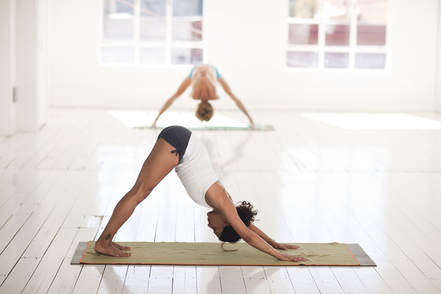
The torse and arms make two thirds of the V shape while the legs make the other third of the pose. Also known as a full body weighted pose, Downward Dog works muscles of the arms, legs and torso.
Being an inversion the pose can be challenging for the breathe requiring the abdominal muscles to work fully.
Muscles which are strengthened during the practice of this pose:
When first practicing Downward facing dog as a beginner the heels may be lifted, the back appears rounded and arms may feel more comfortable out to the side or under the shoulders. With practice and adequate preparation the pose becomes easier and looks more like the classic imagines you might see in magazines, with a lengthened spine, arms forward to the shoulders and heels pressing into the ground with the back of the legs long.
Naturally this pose may not be suited for every individual. Injuries and anatomical anomalies may indicate this pose should not be practiced or practiced with modifications.
To improve your Downward Facing Dog try this adjustments:
- To keep you Downward Facing Dog adequately supported, engage muscles of the shoulders by extending the arms and spread the surface area of the hands and fingers. To do this exert some pressure into the hands and lengthen using ki extension along the floor through the fingers.
- If arched in the back, try flattening the lumbar spine and increase hip flexion by taking pressure off the hamstrings. Gently soften the knees with a slight bend and allow the heels to come off the floor.
- To lengthen the hamstrings and bring heels closer to the ground practice bending one knee and pressing the opposite heel into the floor. “Walk the dog” slowly stretching one side at a time.
- Practice “flirting” with the dog. Preparing for the full pose by using gentle mindful movements that stretch, flex and strengthen the different muscles involved in the full pose. Use simple movements like walking the dog, taking the feet wider apart, bringing the feet closer together, wiggling the hips and practicing abdominal engagement. Be mindful of the breathe and increase the frequency of your practice.
Downward Facing Dog can be a challenge for anyone new to yoga but it is a full body pose that helps improve strength and with practices like ‘flirting with the dog’ can improve flexibility of the body. Use downward dog as a transition pose or make it the focus of your practice. Either way I think you will enjoy this all round asana.
References
Coulter, David (2017) Anatomy of Hatha Yoga; Body and Breath Inc, USA
Kaminoff, Leslie and Matthews, Amy (2012) Yoga Anatomy; Human Kinetics, USA



 RSS Feed
RSS Feed